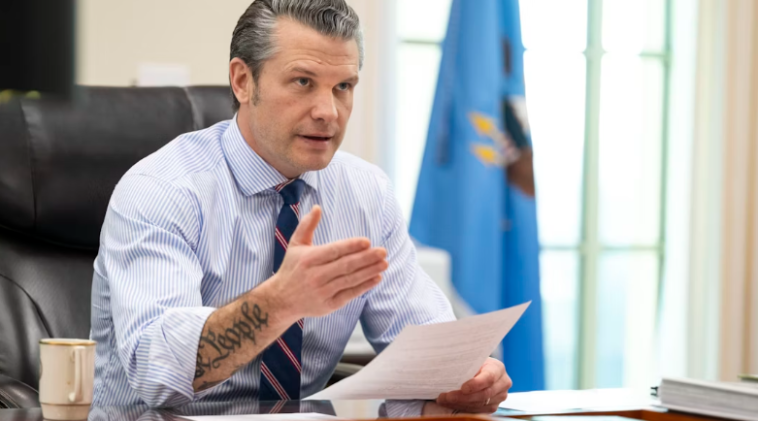In a decisive effort to refocus U.S. military academies on their core mission of producing elite leaders, Defense Secretary Pete Hegseth announced the immediate elimination of Diversity, Equity, and Inclusion (DEI) initiatives from all service academies. The move, hailed by supporters as long overdue, signals a clear shift away from what Hegseth described as “distractions that weaken our military effectiveness.”
Restoring the Warrior Ethos
Hegseth, a former Army officer and Fox News contributor, has consistently criticized DEI and social justice programs, arguing they undermine the military’s values of merit, discipline, and combat readiness. His latest directive aims to bring military education back to the basics: leadership development, merit-based advancement, physical and mental toughness, and strategic excellence.
“Our mission is warfighting,” Hegseth declared. “Social experiments have no place in training future warriors. Our academies will no longer be platforms for identity politics and ideological indoctrination. They will be institutions that instill discipline, honor, and excellence.”
What’s Being Cut
Hegseth’s plan removes DEI courses, seminars, and workshops that have been mandatory for cadets at institutions like West Point, the Naval Academy, and the Air Force Academy. Programs that previously focused on concepts such as “implicit bias,” “white privilege,” and “gender equity” will be eliminated or replaced with training designed to foster unity through shared purpose and a common mission.
The move also halts identity-based graduation ceremonies and celebrations, such as those for specific racial or gender groups. Instead, all recognition ceremonies will focus on the collective achievements of cadets based on merit and service, not demographic labels.
A Return to Meritocracy
Hegseth emphasized that future policies will reflect the military’s traditional merit-based structure, where success is determined by performance, not quotas or identity markers. “We will not sacrifice the strength of our military to achieve ‘diversity goals.’ Diversity naturally exists when you select the best of the best,” he said. “Our military should reflect excellence, not equity.”
This aligns with the broader approach of President Donald Trump’s administration, which has been systematically rolling back DEI initiatives across federal institutions. Trump has called DEI “a toxic ideology that divides rather than unites,” and his executive order eliminating DEI from federal agencies now extends fully to the military.
Supporters Praise the Decision
Conservative lawmakers and veterans groups have applauded the move, arguing that DEI policies have been detrimental to the military’s overall preparedness and morale. Senator Tom Cotton, an outspoken critic of DEI in the armed forces, called the announcement “a victory for military effectiveness.”
“This isn’t about exclusion—it’s about getting back to basics,” Cotton said. “The military’s job is to win wars, not cater to social movements that have nothing to do with national defense.”
Retired Marine Corps General Jack Keane echoed the sentiment, adding, “Every second spent on DEI is time taken away from preparing for combat. We need to train warriors who are ready to fight and win.”
Criticism from the Left
Predictably, the move has drawn criticism from left-leaning organizations and activists, who argue that diversity in leadership is essential for an inclusive and effective military. Some Democratic lawmakers have warned that eliminating DEI programs could hinder recruitment efforts, especially among women and minority groups.
However, Hegseth dismissed these concerns, pointing to the fact that the military has always attracted individuals from diverse backgrounds without the need for mandated quotas or ideologically driven initiatives. “We’re not shutting anyone out,” he said. “We’re simply shifting the focus to what truly matters—readiness, discipline, and winning.”
Early Signs of Impact
Though still in the early stages of implementation, the directive is already reshaping the military academies’ curricula. Courses previously focused on “unconscious bias” have been replaced with classes on military history, strategy, and leadership. Physical fitness standards, which had been lowered under some DEI-based policies, are being reinstated at higher levels to ensure combat preparedness.
Conclusion: Prioritizing Readiness Over Ideology
Hegseth’s sweeping reform is expected to have long-term implications on the military’s culture, shifting it back to its core mission of defense and combat excellence. His message is clear: The U.S. military exists to protect and defend the nation, not to serve as a laboratory for social engineering.
As the changes take effect, supporters believe this move will produce a new generation of military leaders equipped to handle the challenges of the battlefield without being distracted by divisive social agendas. By prioritizing merit, unity, and readiness, Hegseth aims to ensure that America’s armed forces remain the strongest and most capable in the world.
Pete Hegseth: “The single dumbest phrase in military history is ‘our diversity is our strength.’ I think our strength is our unity. Our strength is our shared purpose.”
— Joey Salads (@JoeySalads) February 8, 2025


